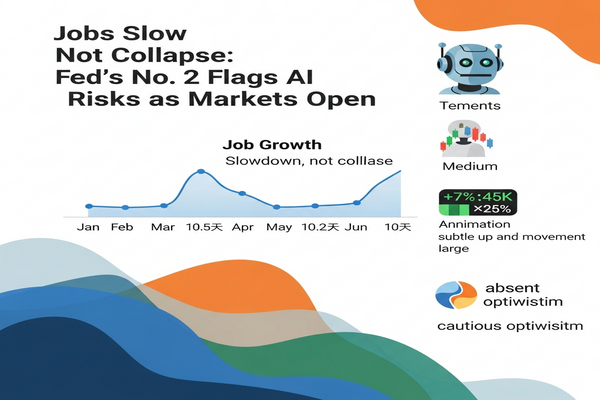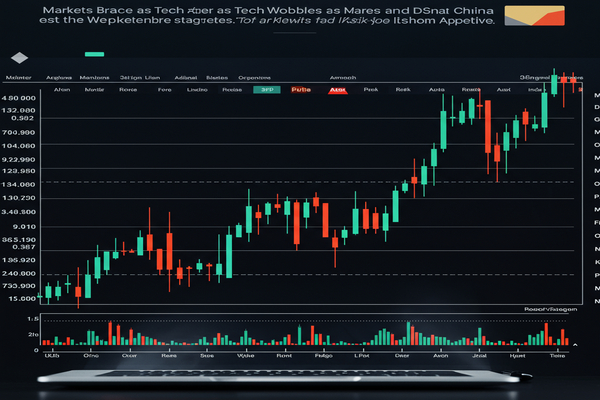
US intelligence finds Israeli military lawyers flagged potential war crimes. American agencies intercepted assessments that Israel’s own military lawyers saw evidence that could support war crimes charges for the Gaza campaign. That matters now because U.S. arms and political support are central to the operation and the revelation reached top policymakers during active conflict. In the short term, markets may react to heightened geopolitical uncertainty and policy debate in Washington. In the long term, legal scrutiny could influence defence procurement, aid flows, and investor risk appetite across the United States, Europe, the Middle East, and emerging markets. Historically, legal and political shocks have lifted safe havens and pressured regional assets. The timing of the leak intensifies the near-term sensitivity of oil, currencies, and risk assets.
Equities and investor sentiment
Risk premium returns as geopolitical scrutiny reaches policy circles
The revelation that U.S. intelligence captured concerns from Israeli military lawyers places a fresh risk premium on equities. Investors often react quickly when legal accountability enters conversations between allies and capitals. In the coming session, risk appetite may ebb as traders price in greater political uncertainty and potential policy shifts from Washington. European markets remain sensitive because of diplomatic ties and the region’s energy exposure. Asian markets may show a mixed reaction depending on local liquidity and risk tolerance. Emerging markets can face outflows if global investors opt for safer assets. The immediate effect is likely to be uneven across sectors. Exporters and companies with exposure to the region can see heightened volatility. Financials and cyclical names may underperform while defensive sectors traditionally attract capital in uncertain times.
Fixed income and safe-haven flows
Bond yields may soften as demand rises for security
When geopolitical concerns intensify, capital often shifts toward government bonds and other safe-haven instruments. Yields in core government debt could fall as prices rise, reflecting an increased demand for protection. The United States and Germany typically benefit from this dynamic. This reaction would be consistent with past episodes where political or legal revelations affected allied military operations. Central bank communication will matter. If officials emphasize stability, moves could be contained. If policy debate in Washington becomes prolonged, the term premium may change and push real rates lower. Market participants will watch auction results and liquidity conditions closely because they will provide clues about how persistent the demand for safety is likely to be.
Oil, commodities and regional exposures
Energy and supply risk remain focal points for traders
Energy markets are particularly sensitive to developments in the Middle East. Any perceived risk to production or shipping routes can lift oil and commodity prices. The intel revelation and ensuing political debate increase the probability of supply concerns entering investor calculations. Short-term spikes are common when conflict-related uncertainty rises. Over longer horizons, sustained legal scrutiny affecting military operations could alter the calculus for regional security cooperation and logistics, which would feed back into commodity pricing. Traders will monitor shipping reports, OPEC commentary, and regional diplomatic activity for signs of escalation or de-escalation. Demand patterns in Asia and Europe will determine how persistent price moves might be.
Currency markets and capital flows
Safe currencies strengthen as risk assets wobble
Currency markets typically reflect risk sentiment shifts rapidly. In a risk-off environment, currencies considered safe tend to appreciate while higher-yielding or commodity-linked currencies face pressure. The United States dollar often performs well when geopolitical uncertainty rises because investors view it as a liquid refuge. European currencies may react to any perceived spillover into energy or trade disruptions. Emerging market currencies can be vulnerable if capital flows turn negative. The immediate movement will depend on how investors interpret Washington’s response and whether aid or policy positions change. Central bank statements and intervention talk could then determine whether moves are temporary or more structural.
Policy implications and longer-term questions
Legal scrutiny could reshape aid, procurement, and investor expectations
The deeper consequence of the intelligence revelation may be political rather than purely market driven. If the debate in Washington about complicity gains traction, it could influence future aid packages and defence procurement practices. That would matter for companies and sovereigns that are tied to military supply chains and for investors who price long-term fiscal commitments. The situation also raises questions about accountability and transparency that can affect investor confidence in the region. Historically, episodes where legal or political scrutiny intersect with military operations have led to renewed policy reviews and adjustments in how support is delivered. Markets will watch legislative and executive branch signals closely. For now, the key is that the story has inserted an additional source of uncertainty into the global risk equation at a time when market participants are already sensitive to policy and macro risks.
As trading begins, expect market moves to reflect rapid reassessment of geopolitical risk and policy direction. Short-term reactions will hinge on headlines and official responses. Longer-term effects will depend on the scope of any policy changes and the duration of legal scrutiny. For market participants, the important factor is how quickly clarity emerges from Washington and allied capitals. That clarity will shape whether the current uptick in risk premia becomes a fleeting repricing or a more prolonged adjustment.








